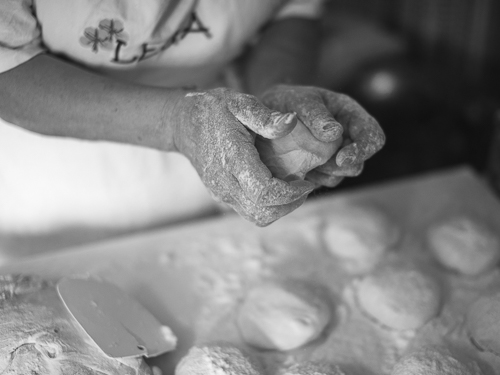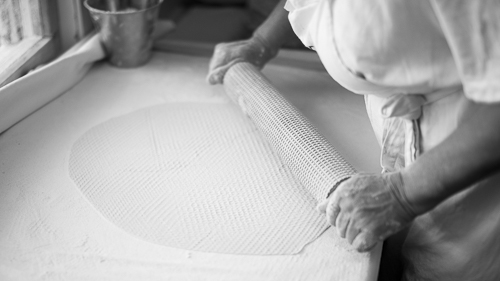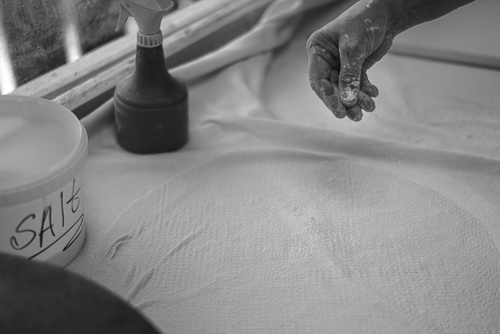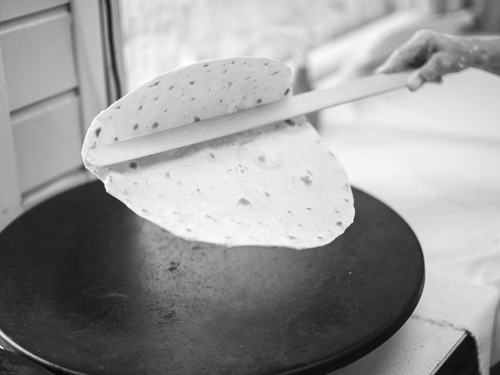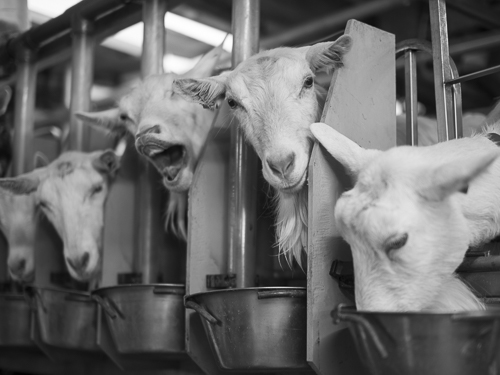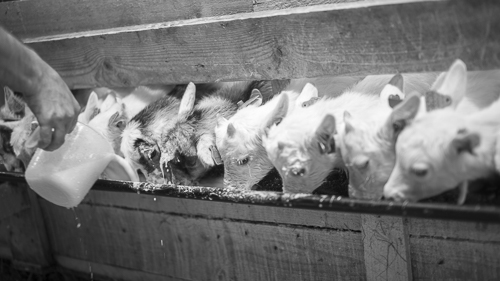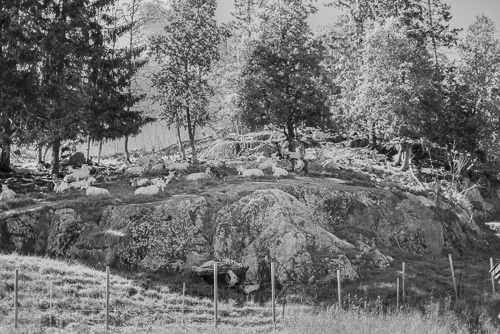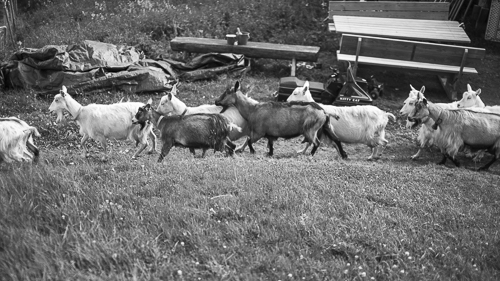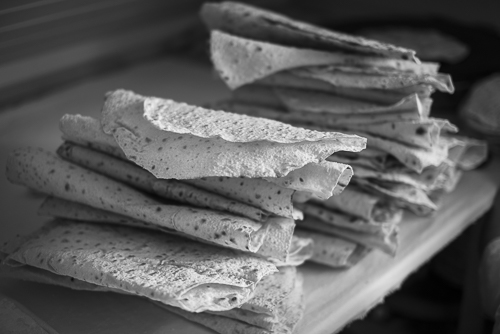 Pizza crusts
Pizza crusts
While doing a course on chair-making at Raulandsakademiet, the director told us that we could buy various farm products like cheese and pizza crusts at the reception. Since I want to support local agriculture, I bought some cheese and kling before I left. Having come back some days later in order to go to a bird-watching course, I decided to contact the producer. Since she accepted my inquiry, I took some time off the course to do an interview instead.
Having arrived, I entered a small building and went upstairs where Gro Hommo and a female worker were making pizza crusts.
Gro picked the dough from a kneader and put it on a bench. She divided up the dough in small parts, weighed it, applied flour to the dough and kneaded it, forming a bun.
Next, the worker, who was from Ukraine, put the “buns” on a dough roller, which turned them flat. Then, Gro lifted them up one by one by means of a small wooden ruler and laid it on a workbench where she flattened both sides by means of a roller pin.
Next, she applied salt and sprayed water on the dough.
Finally, when the dough was ready, she put it on a hot electrical griddle and turned it upside down when it had been baked. Then, she baked the other side and put the finished pizza crust on another bench.
She had 5 griddles on which she could put the finished dough and all of them were quite hot and I had to be careful to avoid being burnt. This was really hard work in a warm room.
I asked Gro if they were growing wheat at the farm, but she told me it wasn’t possible since it was located at about 700 metres above sea level, making it too cold. Instead, she was using wheat flour from Kvelde flour mill. This made it possible to sell the bakery products with a mark of excellence: Spesialitet – unik smak . In addition, she used olive oil from Uliveti Castel San Martino. Incidentally, a man from Rauland was importing olive oil from that farm in Italy.
In fact, this way of making pizza crusts is Gro’s idea, but she has never applied for any kind of protection like a patent because it’s expensive and time-limited.
The pizza crusts would be sold to restaurants, but they are also sold in various shops in south-east Norway.
Gro and her husband bought the farm about 40 years ago. While he was working outside the farm, she was tending goats because they were manageable for one person. The milk from the goats were used to make cheese. Gradually, she has expanded the farm and now there are about 250 goats and some tens of kids.
Gro told me that about half the goats were on a mountain farm, while the kids, the young and the old goats were back home at the farm.
Artificial insemination is used at different times of the year such that some of the goats produce milk all year, making it possible to make cheese all year too.
Gro also showed me the farmhouse dairy where brown goat cheese was being made. Besides, she showed me two storerooms for storing cheese, being located next to the dairy.
I asked her about the simple sign on the road passing the farm: Raundalen, the place where the farm is located. In fact, she didn’t want lots of tourists to arrive at the farm, but she had a farmhouse shop where those in the know could buy the farm’s products.
Next, we went back to the bakery since there were more pizza crusts to make. Some time later, a young man entered the bakery and Gro told me that he was the husband of the woman with whom she was working. Getting workers from Norway is difficult and this was the reason for having workers from Ukraine. Gro asked me if I wanted to see the goats since he was tending them and I accepted, of course.
Wearing clothes and boots from the farm, I was allowed to enter the barn. Having entered, I could see the Ukrainian man let the goats enter a part of the barn, which was used for milking. Instead, they were fed concentrated feeds and when they were finished, they were allowed to go outside again.
Next, it was time to feed the kids. First, he opened a lid, letting the kids have access to a trough where he poured raw milk such that they could drink it.
Instead, the small kids were allowed to drink from a small cup filled with raw milk. Finally, the smallest kids were lifted and held up while drinking from the cup. The worker told me that he had to treat them with care because they could get diarhorea if they eat too much.
Next, he let the goats on the hill through two gates to the meadow below the house where they could enter the barn.
He told me that they prefer to stay inside at night even though they are allowed to go outside if they want. Anyway, the goats can go outside at daytime all year and the cold winters lead to that they get quite shaggy.
This farm is selling kid meat from male kids. Instead, most male kids are just finished off at birth and the meat is not eaten.
When I was about to leave, I could hear the sound of the rolling pin and the dough roller from the bakery. Obviously, being a farmer requires lots of hard work.
The last day at Raulandsakademiet, we were served kid meat from Lega farm. I can honestly say that it was delicious and the meat was the most tender I’ve ever tasted.
Both the farmhouse dairy and the bakery will move to Rauland because the present premises are too small. Economic support from Innovation Norway makes this possible.
As told in various radio programmes, goat and kid are separated soon after birth, most of the goat milk is sold to Tine, goats had another diet in bygone times, which added a very strong taste to the goat cheese, while it’s milder now, the goats are milked twice daily and they really appreciate being caressed after milking, Gro brings the goats she likes best to an annual outdoor market called Dyrskun in Seljord, Gro and her family use kid meat for sausages, pinnekjøtt and fårikål, Gro was running the farm on her own for many years, but now her son is running the farm.
This farm makes the following products:
brown goat cheese
white goat cheese called Stavsfjell
flatbread two of them are made from flour from Kvelde mill and one of them is made from whey and another one is made from mash instead of flour.
pizza crust
prim is a spreadable goat cheese with added sugar
cow cheese called Heimros made from cow milk from the neighbouring farm.
a cheese called knubbost corresponding to feta cheese
a blue cheese called Vehus
cream cheese
crispbread which is called knekkebrød
kling which is a local word for lefse
kid meat
On request, Lega can make yogurt, ice cream, sour cream and butter.
Last but not least, Lega is placed in a beautiful part of Telemark and it’s really worth going there.
